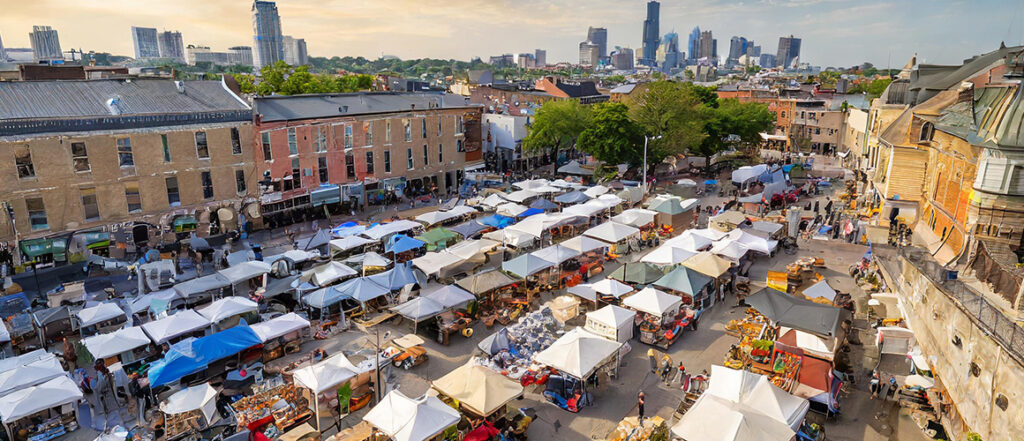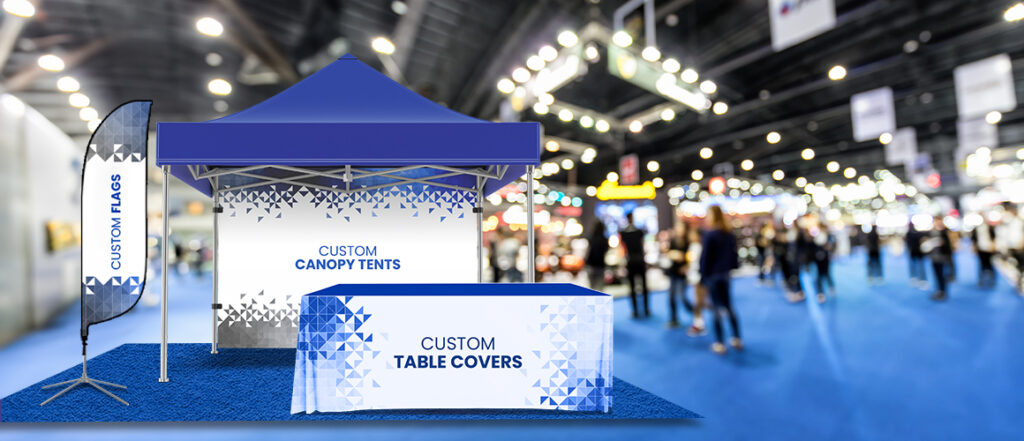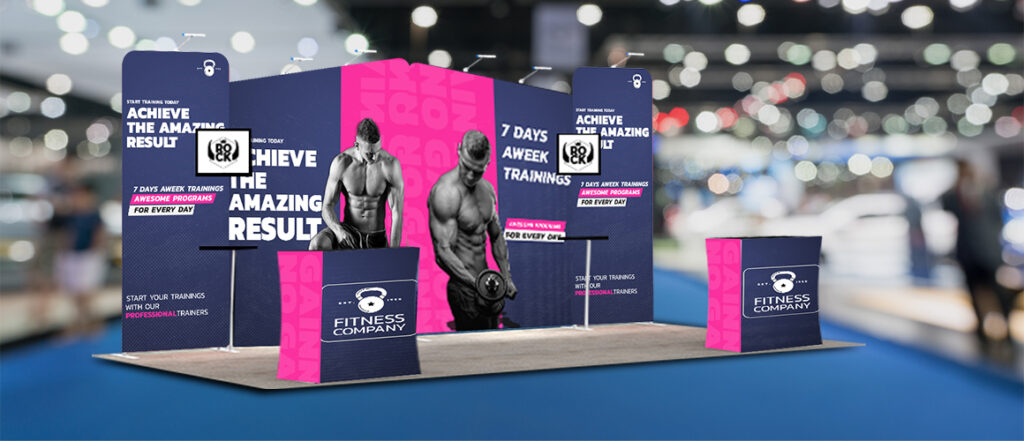It is very important to pick the right setup for events, whether they are indoor or outdoor fairs, business conferences, or expos. People who want to display often choose between canopy tents and trade show marketing booths. Each has its own pros and cons. Let us look at how tents and trade show booths work in different types of event settings and what you need to think about in each case.

Canopies: Embracing the Great Outdoors
For outdoor events like fairs and concerts, trade scan be used in a lot of different ways. They protect you from the weather and make the area open and inviting for interaction. These are the reasons why they shine outside:
1. Weather Resistance: Mother Nature decides what happens at outdoor events, so being able to handle bad weather is very important. With their strong frames and weatherproof materials, trade show canopy kits protect your exhibition displays from rain, wind, and direct sunlight, so it stays useful and appealing no matter what the weather report says.
2. Flexibility: Canopies come in different shapes and sizes, so vendors can use them in a range of outdoor areas. Custom canopy tents can be made to fit any space, from a large field to a small street corner, while still holding all the necessary show items and marketing materials.
3. Visibility: In crowded public areas, event branding is important for getting people to come. When there are a lot of sellers, canopies stand out and serve as beacons. Strategic placing and bright signs can help people see your booth even more, bringing more people to it.
Here are a few factors that should be considered while looking for Canopy Tents:
Size and Dimensions:
- Consider the space needed for people or items underneath.
- Check dimensions for both setup and storage.
Material and Durability:
- Look for weather-resistant fabrics like polyester.
- Consider sturdy frame materials like steel or aluminum.
Portability and Ease of Setup:
- Opt for lightweight tents with carrying bags.
- Choose models with simple setup features like pop-up designs.
Stability and Wind Resistance:
- Ensure sturdy legs and secure anchoring options.
- Check wind resistance ratings for added stability.
Ventilation and Airflow:
- Seek tents with mesh panels or vents for airflow.
- Prevent overheating and stuffiness on hot days.
Waterproofing and UV Protection:
- Confirm waterproofing with sealed seams and coatings.
- Look for UV-resistant fabrics to protect against sun exposure.
Versatility and Customization Options:
- Consider tents with removable sidewalls or adjustable height settings.
- Explore accessories like awnings or screen enclosures for added functionality.
Price and Value for Money:
- Evaluate budget constraints against durability and features.
- Compare prices and read reviews for overall value.
Trade Show Booths: Conquering Indoor Spaces

Indoor events like expos and business conferences are tougher because there is not always a lot of room and people are fighting for attention. Trade show booths provide an organized and adaptable way to get around in these settings:
1. Space Optimization: Indoor venues may have strict rules about how big and how to set up booths, so exhibitors must make the most of their area. Trade show booths are made to be as efficient as possible, so they can easily fit product displays, sales materials, and interactive elements into a small space.
2. Brand Immersion: Outdoor events let people move around easily, but indoor events keep people in one place and control the environment. Through creative design, interactive demos, and multimedia presentations, trade show event booths can create brand experiences that are truly immersive and leave a lasting impact on visitors.
3. Audience Engagement: Indoor events need a specific way to engage with the audience, which is usually made up of business professionals and possible clients. Trade show booths allow for meaningful interactions by offering one-on-one consultations, product demonstrations, and chances to network, which leads to the creation of valuable contacts and leads.
Here are a few factors that should be considered while looking for Booth Tents:
Size and Layout Flexibility:
- Consider the space needed for product displays, demonstrations, and attendee interactions.
- Look for booths with customizable layouts to accommodate various booth sizes and configurations.
Material Quality and Professional Appearance:
- Opt for booths made of high-quality materials that convey a professional image.
- Choose sleek designs and finishes that align with your brand aesthetic.
Portability and Easy Assembly:
- Select booths that are lightweight and easy to transport to different trade show venues.
- Look for booths with simple assembly features to minimize setup time and effort.
Stability and Structural Integrity:
- Ensure that the booth structure is stable and sturdy, especially if it incorporates features like shelving or signage.
- Look for booths with reinforced frames and secure anchoring options for added stability.
Visibility and Brand Exposure:
- Choose booth designs that maximize visibility and attract attention from trade show attendees.
- Consider options for branding elements such as custom graphics, banners, and signage.
Functionality and Interactivity:
- Seek booths with built-in features like lighting, audiovisual equipment, and interactive displays to engage visitors.
- Consider the layout and flow of the booth to facilitate product demonstrations and customer interactions.
Customization and Brand Integration:
- Look for booth event banners that offer customization options to showcase your brand identity and messaging effectively.
- Consider integrating elements such as branded colors, logos, and imagery throughout the booth design.
Cost-Effectiveness and Return on Investment:
- Evaluate the overall cost of the booth against its durability, functionality, and potential for generating leads and sales.
- Consider factors such as rental versus purchase options, as well as ongoing maintenance and storage costs.
Choosing the Right Setup: Case Studies and Examples
Let us look at some real-life examples of trade show booths and canopies that worked well in a variety of event settings:

1. Outdoor Fair: At a local artisan market, one seller set up a canopy with bright banners and string lights hanging from it. This made the market feel festive, which drew people in. Even when it rained unexpectedly, the strong canopy kept things dry and did a good job of showing off handmade goods.
2. Indoor Expo: A tech company that was at a trade show chose a sleek, modular trade show booth with live product demos and interactive touchscreen screens. The design of the booth made the best use of the floor space and prompted people to interact with the newest products.
3. Corporate Conference: A renewable energy company built a canopy using eco-friendly materials and solar panels for a business meeting that was all about sustainability. The roof was a useful shelter and a sign of how committed the company was to taking care of the environment.
Finally, trade show booths and trade show canopy kits are not always the best choice for events because each has its pros and cons that should be considered. Picking the right setup is important if you want to reach your goals and leave an impression on attendees, whether you are braving the weather at an outdoor fair or making a statement at a business conference. When exhibitors know the specific problems and use useful solutions, they can improve their appearance and stand out at any event.


 Posted in
Posted in